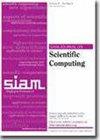Generalizing Lloyd’s Algorithm for Graph Clustering
IF 2.6
2区 数学
Q1 MATHEMATICS, APPLIED
引用次数: 0
Abstract
SIAM Journal on Scientific Computing, Volume 46, Issue 5, Page A2819-A2847, October 2024.Abstract. Clustering is a commonplace problem in many areas of data science, with applications in biology and bioinformatics, understanding chemical structure, image segmentation, building recommender systems, and many more fields. While there are many different clustering variants (based on given distance or graph structure, probability distributions, or data density), we consider here the problem of clustering nodes in a graph, motivated by the problem of aggregating discrete degrees of freedom in multigrid and domain decomposition methods for solving sparse linear systems. Specifically, we consider the challenge of forming balanced clusters in the graph of a sparse matrix for use in algebraic multigrid, although the algorithm has general applicability. Based on an extension of the Bellman–Ford algorithm, we generalize Lloyd’s algorithm for partitioning subsets of [math] to balance the number of nodes in each cluster; this is accompanied by a rebalancing algorithm that reduces the overall energy in the system. The algorithm provides control over the number of clusters and leads to “well centered” partitions of the graph. Theoretical results are provided to establish linear complexity and numerical results in the context of algebraic multigrid highlight the benefits of improved clustering. Reproducibility of computational results. This paper has been awarded the “SIAM Reproducibility Badge: Code and data available” as a recognition that the authors have followed reproducibility principles valued by SISC and the scientific computing community. Code and data that allow readers to reproduce the results in this paper are available at https://github.com/lukeolson/paper-lloyd-data and in the supplementary materials (paper-lloyd-data.zip [88.1MB]).
图形聚类的劳埃德算法推广
SIAM 科学计算期刊》,第 46 卷第 5 期,第 A2819-A2847 页,2024 年 10 月。 摘要聚类是数据科学许多领域的常见问题,应用于生物学和生物信息学、理解化学结构、图像分割、构建推荐系统等许多领域。虽然有许多不同的聚类变体(基于给定的距离或图结构、概率分布或数据密度),但我们在此考虑的是图中节点的聚类问题,其动机来自多网格和域分解方法中离散自由度的聚合问题,用于求解稀疏线性系统。具体来说,我们考虑的难题是如何在稀疏矩阵图中形成平衡的簇,以用于代数多网格,尽管该算法具有普遍适用性。基于 Bellman-Ford 算法的扩展,我们对 [math] 的 Lloyd 子集划分算法进行了推广,以平衡每个簇中的节点数量;同时还采用了一种再平衡算法,以降低系统的总体能量。该算法可控制簇的数量,并导致图的 "居中 "分区。理论结果确定了线性复杂性,代数多网格的数值结果突出了改进聚类的好处。计算结果的可重复性。本文被授予 "SIAM 可重现徽章":代码和数据可用",以表彰作者遵循了 SISC 和科学计算界重视的可重现性原则。读者可以通过 https://github.com/lukeolson/paper-lloyd-data 和补充材料(paper-lloyd-data.zip [88.1MB])中的代码和数据重现本文的结果。
本文章由计算机程序翻译,如有差异,请以英文原文为准。
求助全文
约1分钟内获得全文
求助全文
来源期刊
CiteScore
5.50
自引率
3.20%
发文量
209
审稿时长
1 months
期刊介绍:
The purpose of SIAM Journal on Scientific Computing (SISC) is to advance computational methods for solving scientific and engineering problems.
SISC papers are classified into three categories:
1. Methods and Algorithms for Scientific Computing: Papers in this category may include theoretical analysis, provided that the relevance to applications in science and engineering is demonstrated. They should contain meaningful computational results and theoretical results or strong heuristics supporting the performance of new algorithms.
2. Computational Methods in Science and Engineering: Papers in this section will typically describe novel methodologies for solving a specific problem in computational science or engineering. They should contain enough information about the application to orient other computational scientists but should omit details of interest mainly to the applications specialist.
3. Software and High-Performance Computing: Papers in this category should concern the novel design and development of computational methods and high-quality software, parallel algorithms, high-performance computing issues, new architectures, data analysis, or visualization. The primary focus should be on computational methods that have potentially large impact for an important class of scientific or engineering problems.

 求助内容:
求助内容: 应助结果提醒方式:
应助结果提醒方式:


